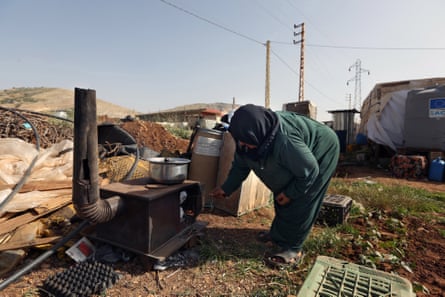1. The war in Syria shows no signs of ending. People continue to flee, and refugees in neighbouring countries are now losing hope that they can return
Inside Syria, the situation has continued to worsen, with fighting intensifying in all regions and the economy and services in a state of general collapse. This is driving yet more people to leave, but is also having a profound impact on those who have already escaped to neighbouring countries.
When people flee from war, they usually do so hoping to return soon. So they move nearby, perhaps to family or friends in a nearby town, or just across the border, where they can keep an eye on their homes and livelihoods. But after more than five years of conflict, many Syrians have now abandoned that hope. Their homes have been devastated, their families torn apart, and there is little prospect for peace. With nothing left, and their places of exile under increasing strain, hundreds of thousands of people are now ready to travel much further to find the security they so desperately need.
2. Living as a refugee in neighbouring countries is untenable for many refugees, who are not permitted to work and are sliding deeper into poverty
For millions of Syrians, their first place of safety was a neighbouring country – like Lebanon, Jordan, Turkey, Egypt and Iraq. But few refugees can continue to pay rents at all, even on tiny and crowded rooms. Many refugees face eviction from their places of shelter.

In most countries, refugees are not allowed to enter the labour market formally and face sanctions if caught. In Jordan, for example, they risk being returned to the camps; in Lebanon, they are forced to sign a pledge not to work if they wish to renew their residency status.
Without income, people are forced, first, to spend their savings, and then to take on debt. Even worse options may then lie in store. After years of gruelling costs, many are simply no longer able to pay for rent, food or basic items.
3. There is not enough international aid to help refugees in the region
Normally, refugees might turn to aid agencies like UNHCR, which are running many programmes to help them survive. But the scale of the problem is so large, and it has been going on for so long, that donors are struggling to find the money to pay for these schemes. When the numbers of Syrian refugees arriving in Europe surged last month, UNHCR began to receive new donor pledges to increase aid in neighbouring countries. Even so, this year’s international appeal for Syrian refugees is just over half funded. Recently, World Food Programme vouchers were cut for thousands of refugees, forcing many into “negative coping strategies”, including begging and child labour.

In Jordan, many refugees have also lost free access to healthcare. Almost 60% of adults with chronic conditions are now forced to survive without medicine – up from 23% in 2014. Refugees in Iraq, Jordan, Lebanon and Egypt say cuts like these are the last straw, leaving them little choice but to leave.
4. Children are going too long without an education
Syrians prize education highly. But in Jordan, Egypt, Lebanon and Turkey there are simply not enough opportunities for Syrian children to be educated. In Jordan, 90,000 Syrian children are going without a formal education, and 20% of refugee children have abandoned school in order to work. Many girls are losing out after being forced into early marriage, another survival mechanism. Even in Lebanon, where education is free for Syrian children, transportation costs are prohibitive and many have to miss classes in order to support their families; 200,000 will be out of school this year, and young people looking for a university education have almost no options at all. If they are to get the skills to live a productive life, to go back home and rebuild after the war, parents of Syria’s refugee children arriving in Europe say education is crucial.
5. Countries in the region hosting four million refugees, without commensurate international support, have imposed new restrictions
Neighbouring countries have not been compensated for welcoming huge refugee populations, which has put an enormous strain on their infrastructures. In tiny Lebanon, host to well over one million Syrian refugees, the government has resorted to imposing new regulations making it harder for Syrian refugees to gain asylum. Most people fleeing Syria can only enter Lebanon if they show border guards an air or ferry ticket to Turkey. Refugees already in Lebanon must pay the equivalent of £130 per year to stay, as well as pledging not to work. In Jordan, the government requires all Syrians living outside of camps to get new identity documents to access services, but their cost (£27) is simply too high for many to afford.
6. The portrayal of a welcoming Europe on television and social media
Syrians inside and outside the country avidly follow the news. News stories of difficult journeys across the Mediterranean and through the Balkans end in Austria and Germany with scenes of refugees greeted with applause, flowers and teddy bears. For Syrians, the idea that they could seek asylum in a country offering the combination of safety, work prospects and education was worth the steep smugglers’ fees and the danger of getting there. Many also fear the gates will close soon and the only time to travel is now.

So what is the solution? Obviously, all countries with influence must step up efforts to end to the Syrian war. But until there is peace, the countries hosting four million refugees must receive the infrastructure and development support they need while fully funding UNHCR and partner organisations to provide for the basic needs for refugees. We continue to advocate for employment schemes to allow refugees to earn and contribute to local labour markets.
At the same time, refugees must be offered more legal avenues to reach safety in the world’s richer countries through increased resettlement quotas, more flexible family reunification schemes and humanitarian and student visas. Syrian refugees would certainly then think twice before leaving their region and risking their lives on a journey to Europe.
For more information: http://data.unhcr.org/syrianrefugees/regional.php
Join our community of development professionals and humanitarians. Follow@GuardianGDP on Twitter.
